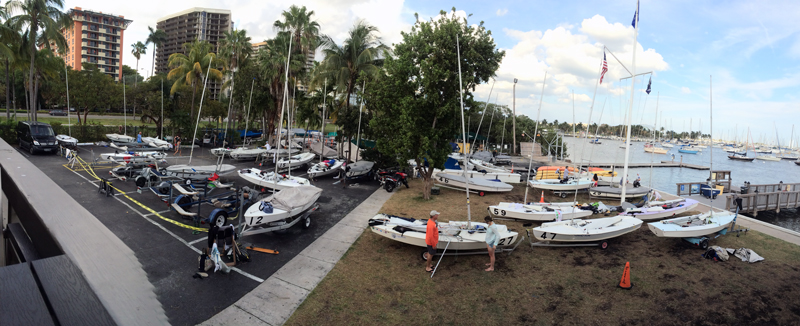I was really, really looking forward to flying home from Miami last Sunday. For the past several years, I’ve driven home after the annual DonQ Snipe regatta… by myself. Even if the drive is trouble-free, there are several unavoidable challenges of doing that 1500 mile stretch of I-95 solo: finding a safe place to pull over and sleep for a few hours. Changing from shorts to jeans in time for the first chilly gas stop. Getting through DC before (or after) rush hour. Getting through New York before (or after) rush hour. Staying awake. Finding entertainment on the radio. Staying awake.

No matter what transportation method you choose, it’s always hard to leave Miami for the trip north.
This year, I planned to skip all that by doing a three hour flyover instead. I’d made the ideal flight reservation: with a late departure on Sunday night, even a longer than usual day of sailing and packing boats would not make me stress about missing it. And thanks to a non-stop back to Providence, I’d be asleep in my own bed by 1:30AM, easy—about the same time I would usually be pulling into a South Carolina rest area for a few hours’ nap.
Those perfect flights, of course, are sometimes cancelled. Which is exactly what happened Sunday morning, due to a snowstorm in Providence that was scheduled to peak around midnight. And thanks to spring break, airline promotions, and who knows what else, the next available flight didn’t leave until Tuesday midday.
Thankfully, there was an alternative: my friend Andrew was about to drive his van and two Snipes back to Rhode Island. So I hopped into the passenger seat, transforming myself from passive airline passenger to active co-pilot. Andrew and I first drove home from Miami together in 1992, and we’re both members of the “get there” club. So I was quite sure I’d be home before Tuesday’s flight even left the gate.
I was right. And I was also reminded how much easier it is to do a long drive with two drivers. There’s the obvious—I could nap in the plush van bunk while still making progress toward home—but there’s also the less obvious: Rehashing the weekend of sailing makes the first few hundred miles fly by. Even when we ran out of specific regatta anecdotes, there were other things to talk about: boat building, rigging, and tuning ideas. Sail shapes. How long does a Snipe jib really remain competitive? We “solved” all of that and more before we even got out of Florida. We also reminisced about highlights from previous road trips (including the Deer in the Headlight adventure). And by mutual agreement, we tried not to talk about how smoothly his aging van was running.
An efficient road trip is only possible if all riders are on the same page about pit stops. Andrew shares my philosophy that the less time spent not moving the better, so when the gas gauge clicks down toward empty, we make one stop for food, gas, and bathroom runs. Typically, we’re back on the road again in fifteen or twenty minutes. This trip, we did spend a half hour unloading two Snipes at Severn Sailing Association in Annapolis. But we still managed to beat the New York commuters through the Bronx on Monday afternoon.
26 hours after we’d driven out of Coconut Grove Sailing Club, we arrived at the Providence airport—where’d I’d so optimistically parked my car ten days earlier. Flying is quick, but some years driving is quicker—and it’s always better to be a co-pilot than a passive passenger.